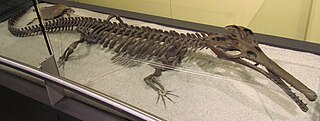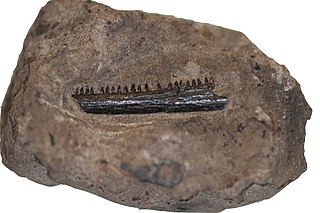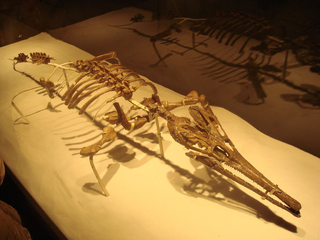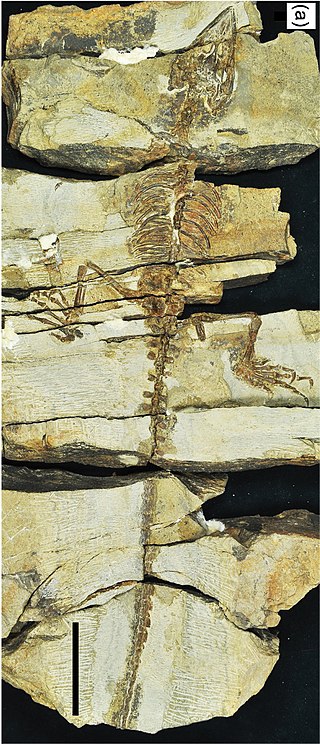
Apatosaurus is a genus of herbivorous sauropod dinosaur that lived in North America during the Late Jurassic period. Othniel Charles Marsh described and named the first-known species, A. ajax, in 1877, and a second species, A. louisae, was discovered and named by William H. Holland in 1916. Apatosaurus lived about 152 to 151 million years ago (mya), during the late Kimmeridgian to early Tithonian age, and are now known from fossils in the Morrison Formation of modern-day Colorado, Oklahoma, New Mexico, Wyoming, and Utah in the United States. Apatosaurus had an average length of 21–23 m (69–75 ft), and an average mass of 16.4–22.4 t. A few specimens indicate a maximum length of 11–30% greater than average and a mass of approximately 33 t.

Lambdopsalis is an extinct multituberculate mammal from the Late Paleocene of China and Mongolia. It is placed within the suborder Cimolodonta and is a member of the superfamily Taeniolabidoidea. Fossil remains have been found in the Late Paleocene Nomogen and Khashat Formations in Nao-mugen and Bayn Ulan of China and Mongolia, dated to 59-55 million years ago from the Thanetian age. Lambdopsalis bulla is the type species of this genus. The genus and species were named by Chow and Tao Qi in 1978.

Archosauromorpha is a clade of diapsid reptiles containing all reptiles more closely related to archosaurs rather than lepidosaurs. Archosauromorphs first appeared during the late Middle Permian or Late Permian, though they became much more common and diverse during the Triassic period.

Champsosaurus is an extinct genus of crocodile-like choristodere reptile, known from the Late Cretaceous and early Paleogene periods of North America and Europe (Campanian–Paleocene). The name Champsosaurus is thought to come from champsai, (χαμψαι) said in an Ancient Greek source to be an Egyptian word for "crocodiles", and sauros, (σαύρος) Greek for "lizard". The morphology of Champsosaurus resembles that of gharials, with a long, elongated snout. It was native to freshwater environments where it likely preyed on fish, similar to living gharials.

Choristodera is an extinct order of semiaquatic diapsid reptiles that ranged from the Middle Jurassic, or possibly Triassic, to the Miocene. Choristoderes are morphologically diverse, with the best known members being the crocodile-like neochoristoderes such as Champsosaurus. Other choristoderans had lizard-like or long necked morphologies. Choristoderes appear to have been confined to the Northern Hemisphere, having been found in North America, Asia, and Europe, and possibly also North Africa. Choristoderes are generally thought to be derived neodiapsids that are close relatives or members of Sauria.

Shokawa is an extinct genus of choristoderan diapsid reptile, known from the Lower Cretaceous of Japan. It is only known from one species, Shokawa ikoi. The only known remains are a postcranial specimen lacking the skull, discovered at the KO2 locality in sediments belonging to the Okurodani Formation near the village of Shokawa in Gifu Prefecture. Shokawa possessed a long neck with at least 16 cervical vertebrae, and closely resembles and is closely related to the smaller choristoderan, Hyphalosaurus. The generic name refers to the village near where it was found, while the specific name honors the collector of the first specimen, one Mr. Ikoi Shibata.
Pachystropheus is a genus of prehistoric reptile, from the Rhaetian of southwestern England. It was named by Erika von Huene in 1935; Huene described Pachystropheus as a choristodere, but this was overlooked for decades until its redescription by Storrs and Gower in 1993. This reevaluation would extend the fossil record of choristoderes back 45 million years. However, other authors consider attribution of Pachystropheus to Choristodera problematic, stating that it depends on vertebral and girdle characters that are also found in the skeletons of aquatic reptiles other than choristoderes; most of the diagnostic features of choristoderes are skull features, but the presence of these cannot be confirmed in Pachystropheus, as there is no confirmed skull material for this taxon. Silvio Renesto (2005) found similarities in the postcranial skeleton of Pachystropheus and the thalattosaur genus Endennasaurus; according to Renesto, these similarities may indicate that Pachystropheus and Endennasaurus are close relatives, but they might as well simply be a case of a convergent evolution triggered by the aquatic lifestyle of both taxa. The placement as a thalattosaur has been supported by other researchers.

Lazarussuchus is an extinct genus of amphibious reptile, known from the Cenozoic of Europe. It is the youngest known member of Choristodera, an extinct order of aquatic reptiles that first appeared in the Middle Jurassic. Fossils have been found in Late Paleocene, Late Oligocene, Early Miocene and possibly Late Miocene deposits in France, Germany, and the Czech Republic. Two species have been named: the type species L. inexpectatus ("unexpected") from the late Oligocene of France. and L. dvoraki from the early Miocene of the Czech Republic. It was not a large animal; with the total preserved body and tail length of L. inexpectatus being just over 30 centimetres. A complete specimen of Lazarussuchus with preserved soft tissue was found from the Late Paleocene of France, but has not been assigned to a species.

Cteniogenys is a genus of choristodere, a morphologically diverse group of aquatic reptiles. It is part of the monotypic family Cteniogenidae. The type and only named species, C. antiquus, was named in 1928 by Charles W. Gilmore. The holotype, VP.001088, was collected in the Morrison Formation, Wyoming in 1881 by William H. Reed. More specimens have been discovered since then, including specimens from the Late Jurassic of Portugal and Middle Jurassic of Britain, which have not been assigned to species.

Monjurosuchus is a genus of choristoderan reptile that lived in what is now China and Japan during the Early Cretaceous. It has large eyes, a rounded skull, robust legs with short claws, and a long, thin tail. Fossils have been found that preserve soft tissue, showing that it had soft skin and webbed feet.

Tchoiria () is a genus of neochoristoderan reptile from the Early Cretaceous of Mongolia. The name Tchoiria comes from the city of Choir which is nearby to where the holotype was found. Tchoiria is thought to have a similar diet to another neochoristoderan reptile, Champsosaurus, due to morphology of the skull. It would hunt in freshwater environments, like the living gharials, where it would prey on many different types of fish and turtles.

Neochoristodera is a lineage of specialised crocodile-like fully aquatic choristodere reptiles. Noted for their long jaws and large size, these animals were predominant across the Northern Hemisphere, occurring in freshwater and coastal environments across the Cretaceous and early Cenozoic.

Philydrosaurus is an extinct genus of choristoderan which existed in China during the Early Cretaceous. The type species P. proseilus was named in 2005. Philydrosaurus was found from the Jiufotang Formation and is slightly younger than Monjurosuchus, which was found from the Yixian Formation.

Ikechosaurus is an extinct genus of choristodere reptile which existed in China and Mongolia during the Early Cretaceous. It contains the species Ikechosaurus sunailinae and Ikechosaurus gaoi. It belongs to the crocodilian-like clade Neochoristodera and was initially assigned to the Champsosauridae by Sigogneau-Russell (1981). Compared to other neochoristoderes, Ikechosaurus has a rather simple dentition, lacking the speciations seen in latter species. It also has parasphenoid palatal teeth, a feature not seen in any other choristodere.

Kunpengopterus is a genus of wukongopterid pterosaur from the middle-late Jurassic Tiaojishan Formation of northeastern China. The genus contains two species, the type species K. sinensis and K. antipollicatus.
Guanlingsaurus is an extinct genus of shastasaurid ichthyosaur from the Late Triassic of China. It grew up to 8.3 metres (27 ft) in length and has a wide, triangular skull with a short and toothless snout.

Chuanqilong is a monospecific genus of basal ankylosaurid dinosaur from the Liaoning Province, China that lived during the Early Cretaceous in what is now the Jiufotang Formation. The type and only species, Chuanqilong chaoyangensis, is known from a nearly complete skeleton with a skull of a juvenile individual. It was described in 2014 by Fenglu Han, Wenjie Zheng, Dongyu Hu, Xing Xu, and Paul M. Barrett. Chuanqilong shows many similarities with Liaoningosaurus and may represent a later ontogenetic stage of the taxon.

Coeruleodraco is an extinct genus of choristoderan known from the Late Jurassic (Oxfordian) Tiaojishan Formation in China. Coeruleodraco is significant as the most complete Jurassic choristodere taxon, as the only other named Jurassic choristodere Cteniogenys is based on fragmentary remains. Although similar to Philydrosaurus in its proportions and postcranial characters, it is distinct in retaining several apparently plesiomorphic characters, including a short snout, paired external nares and an open lower temporal fenestra.
Heishanosaurus is an extinct genus of choristodere reptile from the Early Cretaceous of China. The type and currently only known species is Heishanosaurus pygmaeus. It is unusual as it is much more primitive than other known choristoderes from the Early Cretaceous of Asia, and retains many plesiomorphic characters.

Kosmodraco is a genus of large bodied choristodere from the Paleocene of North America. Originally described as a species of Simoedosaurus, it was found to represent a distinct genus in 2022. Multiple fossil skulls show a relatively short and robust snout and a skull that is considerably wider behind the eyes. Two species are currently recognized, K. dakotensis and K. magnicornis.















